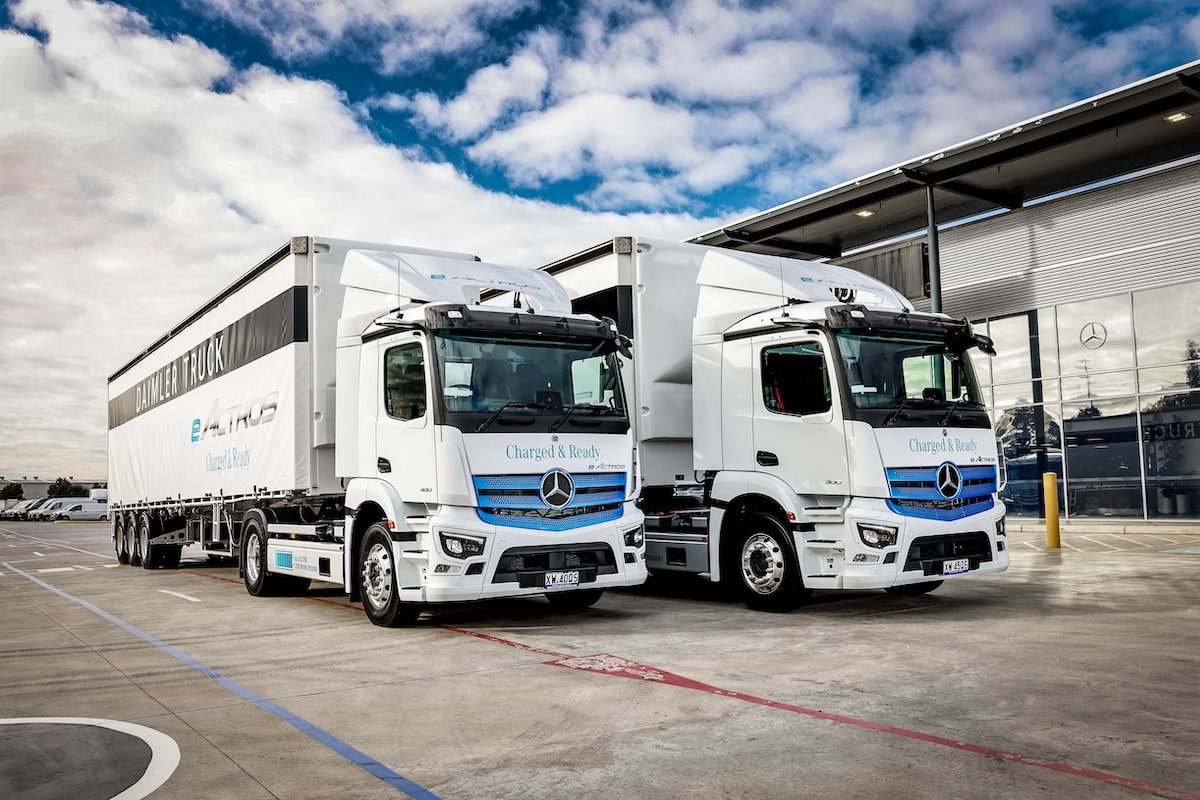Jumping into the cabin of the Mercedes-Benz eActros is simple – put the key in the ignition, turn the truck on, wait for it to go through its initiation process, release the handbrake and press the go pedal. It is at this point that the first strong impression, which this kind of truck gives us, comes into play.
It is surprising just how quiet it is in the cabin as the truck is heading off down the road. This does make for very relaxing driving, and also reduces any vibration. The loudest noise the truck makes is the sound of the tyres against the bitumen.
Of course, this is a Mercedes-Benz, and therefore, as a new truck, it is fitted with all of the latest safety devices which come as a package along with the truck. These include the active brake assist, stability control, lane keeping, attention assist, stability control, rollover prevention, and can also include tyre pressure monitoring.
The camera systems, which are associated with the safety systems, also look out for vehicles ahead and for pedestrians on the road in front of the truck. Because of the relative silence of the truck, there could be a problem for those pedestrians. However, if the truck is traveling 20km/h or under it makes a warning sound, in order to give any pedestrians around the vehicle an audible alert that there is a truck traveling in their vicinity.
In the event of a pedestrian alert set off by the cameras, the truck will activate the autonomous emergency braking system as soon as it detects any danger of a collision between truck and pedestrian.
This driver was not game enough to actually test this system out in the real world, but we are already used to the autonomous emergency braking coming into play, if a vehicle (or any obstacle) in front of the truck is being approached at an excessive speed.
According to Mercedes-Benz, it is possible to charge the batteries from 20 per cent to 80 per cent in one hour and 15 minutes using a 150 kilowatt charger. This 20/80 rule is often mentioned by electric truck developers. Below 20 per cent, there is a risk of running out of charge before reaching a charging facility.
Above 80 per cent, it takes much longer to get to 100 per cent charge after the charger has been able to fill the first 80 per cent relatively quickly. The last 20 per cent will always take much longer as the battery reaches its charging capacity.
Unlike past power buying decisions, the choice of electric motor used in a truck is not a major talking point. Electric motors are now quite generic. With this kind of tech, things like the axle housing, wheel ends and other components are the differentiation items, and in this case they are all identical to those in the diesel Actros.
All of the internal electrics in the cabin are also the same as the standard 24 volt system in the internal combustion engine (ICE). This reduces complexity for the servicing of the trucks, because of the parts’ interchangeability and diagnostics.
As the transition across to zero emission running continues, the intention is to maintain one electrical infrastructure across the range, whether it is diesel, some other kind of ICE, electric or fuel cell. There will be a consistency within all of the system which controls everything, from safety systems to the power train. This is likely to remain the case for some time as the dust settles on the low carbon transition and the preferred technology in each market segment becomes clearer.
Any development in truck design is now specified to be agnostic about how the power is supplied to the drive tyres, so a large proportion of developments being made in trucks are the same no matter the power source.
First Steps
With the wheelbase on this particular model, the eActros has room to fit three batteries. With the current battery chemistry the storage capacity of this array is a claimed 336kWh. Increased range should be possible as new battery chemistry is developed for this truck.
Looking back at the development of Daimler’s first electric truck, the Fuso eCanter, the storage capacity from the fitted batteries doubled in the transition from the first eCanters in the Australian market to the latest version now on sale.
We can regard this eActros as a clear first step for Mercedes-Benz in the electric mode, going from a diesel powered truck straight to one using an eAxle, which has been built from the ground up for future use on both battery electric and fuel cell trucks.
It’s the same story with the truck’s electronics. The designers are no longer developing electronic equipment to run a particular system. They are now building the CANbus systems to be capable of being utilised by numerous iterations of software and other systems for several generations of trucks, as we move towards what is becoming known as ‘software defined vehicles’.
This level of sophistication comes at a high price and Daimler has entered another joint venture/alliance with Volvo Trucks to work together on the development of software. Because this part of the design process is currently a quite dynamic space, the research and development cost can escalate swiftly on an exponential development path. Therefore, even these massive global players have to collaborate to make sure they get an affordable result.
The two truck giants have also collaborated on the CellCentric project to produce a viable fuel cell technology to take them forward into zero emissions technology.
Driving this virtually silent electric prime mover (we might start complaining about intrusive tyre noise in the future), shows us how this transition is likely to play out over time. The technology is being developed and does work.
Anyone waiting for the first 6×4 configuration may have a few years to wait, because 4×2 prime movers predominate in Europe and get the initial funding. However, 6×4 is coming and as this technology matures we should see more efficient batteries, giving us more range.
The introduction of a fuel cell would simply introduce the same truck with a fuel cell and hydrogen tanks instead of batteries. This is our first experience of this kind of truck, but it won’t be our last.
Article With Thanks to Power Torque




